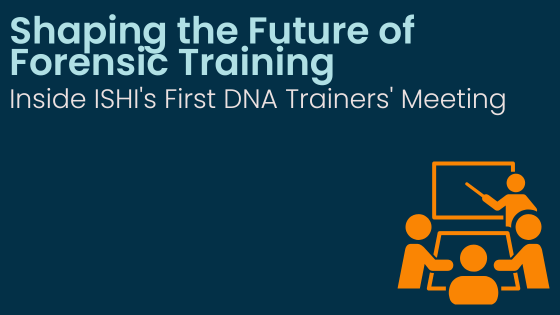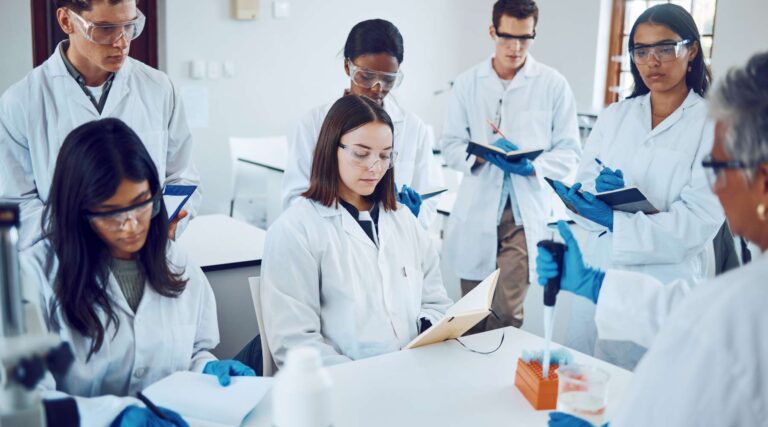This year, the International Symposium on Human Identification (ISHI) is proud to introduce a new addition to its lineup: the DNA Trainers’ Meeting. Recognizing the challenges inherent in forensic DNA analyst training, this meeting was established to enable trainers to share best practices, discuss innovative training strategies, and explore potential improvements in training efficiency.
Below, Eugene Lien and Kelly Elkins, who are co-chairing this inaugural meeting, offer their insights into the creation of this new meeting at ISHI, the pressing issues facing today’s forensic trainers, and what attendees can expect from participating in this workshop.

What is the inspiration behind the DNA Trainers' Meeting and what attendees can expect from this event?
Forensic DNA laboratories have been working on making their DNA analyst training programs more effective and efficient. The training process typically takes 12 to 18 months, and it is not unusual for a lab’s training program to run upwards of 2 years! What if there were ways to cut down the training timeframe without losing quality? Laboratory Directors and DNA Technical Leaders have dedicated meetings/conferences to discuss issues, learn from each other, and improve their lab, but trainers do not. We saw the DNA Trainers’ Meeting as an opportunity for conversations and ideas to emerge. We hope that anyone involved with DNA training in a forensic lab can meet others in the same role, and that a Community of Practice develops.
Who is this meeting designed for and what do you anticipate the format of the meeting to be?
We hope to create a Community of Practice where trainers can feel comfortable discussing important issues and learning from each other. Therefore, this meeting is designed for anyone from a forensic DNA laboratory with a role in training. The format will include talks from trainers from different sized labs since they take different approaches to training as they onboard different numbers of new analysts annually. They will provide an overview of how they conduct training and what they would improve, if given the opportunity. Mentoring is a topic that will be discussed as well since it reduces the chances of new staff becoming unhappy and leaving, which will ultimately save the company time and money. Results from a National study of training in U.S. public labs will also be shared.
What are the most pressing training challenges currently facing forensic laboratories, and how can these be effectively addressed?
One of the most pressing challenges facing forensic laboratories includes the pressure of getting new staff online to process casework as soon as possible. Funding is typically allocated to hiring new staff when there is an immediate need to lower the backlog of cases. However, it might be hard for some to tell their bosses that the funding will not go towards any improvement for at least a year. As a matter of fact, each time a new staff member is hired, existing staff are often pulled from casework to train them, thereby lowering productivity. But everyone must be trained, and their skills must be carefully tested and verified before they can move on to casework. This struggle becomes a balancing act – we try to shorten the training program, but will we still have quality analysts at the end?
Another pressing challenge is to train current staff in new technologies, which includes newer versions of probabilistic genotyping software and new instruments. Labs already struggle to find time to conduct validations, but to train their people takes a special effort. Again, existing staff are often pulled from casework to train others, but the demand for new technologies is so constant that they are not able to contribute much to casework.

How does the rapid evolution of forensic technology impact the training needs of laboratory personnel, and what strategies can be implemented to keep pace?
New forensic technologies, such as Proteomics, Massively Parallel Sequencing, Rapid DNA, and Forensic Investigative Genealogy have emerged within the last 10 years. Even when labs decide not to implement any of these new technologies, staff members need to learn and understand what these new technologies are for. Labs can have ongoing and frank conversations with their academic institutions to assist with these prerequisites so that new staff will have more knowledge when they are hired.
What role does standardization and accreditation play in shaping training programs within forensic laboratories, and how can labs ensure compliance while fostering skill development?
Standards and Guidelines, from well-known organizations such as SWGDAM and OSAC, are valuable tools that can be used to assist labs to create a standardized comprehensive training program for their staff. Standards, such as the FBI’s Quality Assurance Standards for Forensic DNA Testing Laboratories (QAS), include education and training requirements for laboratory personnel involved in forensic DNA analysis. Guidance documents, such as the SWGDAM Training Guidelines, provide a recommended program of standardized study and training for laboratory personnel. Accreditation assessment teams and auditors can review all training documentation to ensure that the goal of the training program is met, and new analysts can be interviewed about their training to determine if the program was effective. The benefits of standardization and accreditation include constantly improving the overall quality and consistency of work when performing forensic DNA analysis and developing the technical skills and knowledge of laboratory staff.
That said, labs must also understand that Standards and Guidelines provide a bare-minimum recommendation for training. To foster skill development, training programs must be somewhat tailored to the individual. After all, one cannot develop an in-depth understanding of DNA amplification without the educational prerequisites. Again, labs need to have ongoing and frank conversations with their academic institutions to assist with these prerequisites. Otherwise, this knowledge may have to be provided by the laboratory and training will take more time.
How can forensic laboratories balance the need for specialized training in emerging areas with the broad foundational knowledge required of all forensic analysts?
From discussions with forensic lab directors and trainers, we found that analysts come with broad foundational knowledge in biology, molecular biology, and biochemistry theory. The labs focus on specialized on-the-job training, geared towards their SOPs, using their approach for interpreting DNA mixtures, and reporting results/conclusions in their format. Labs should not need to reteach the basics of a college degree, but they do need to ensure that new analysts gain competency and meet the FBI DNA QAS. Experts on these emerging areas should be called upon to provide continuing education to ensure that all forensic DNA analysts understand these emerging technologies.
In what ways can mentorship and peer learning be more effectively integrated into forensic laboratory training programs to enhance skill acquisition and professional growth?
Mentoring and training both involve “knowledge transfer” and are important to onboard new employees, but the approach to both is very different. The purpose of the knowledge transfer in Training is to upskill your staff and your workplace. The relationship between the Trainer and Trainee is similar to a Teacher and a Student. The purpose of the knowledge transfer in Mentoring emphasizes long-term career development and personal growth. The relationship between Mentor and Mentee is more personal, confidential, and friendly.
In many ways, labs utilize mentoring during training. New analysts shadow their trainers, are watched carefully, and instructed when they perform methods in the lab for the first few times to ensure that the SOP is followed. The same trainers could also act as mentors by offering general advice based on personal experience and empowering trainees to find their answers. This “general advice” could be anything ranging from where to get lunch to how to organize a casefile. In these cases, the general well-being of trainees may be better. On the other hand, you may not want trainers to slip into a mentoring role, or the relationship can become confusing. If you feel this way, then having different individuals serve as Trainers and Mentors might be the best to keep the roles separate. For analysts thinking about lateral moves or moves to new positions, a mentor outside their lab can also be a great resource.
Ready to enhance your approach to forensic DNA training? Join us at the inaugural DNA Trainers’ Meeting at ISHI. This specialized workshop, led by experts Eugene Lien and Kelly Elkins, offers a platform for trainers to connect, share insights, and explore innovative training strategies.

